When I think “winter,” I think of lush, green garden beds. Surprised? Then let’s talk about how to grow mustard greens in cold weather.
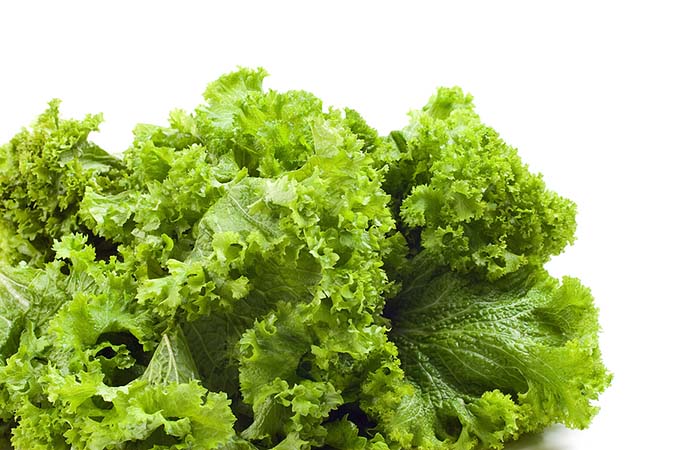
How to Grow Mustard Greens (With Recipe)
When I think winter, I think of lush, green garden beds. I know that might come as a surprise to some of you, but my garden is full of copious swaths of varied and vibrant delicious, nutritious, winter edibles. And by far, mustard greens are the most prolific.
Most of the growing guides say mustard can tolerate light frost, but in my experience, it can take a whole lot more cold than that description suggests.
This article on growing mustard greens is part of our Green of the Month series. To read the rest of the articles in the series, click here.
Now, I do have a few tricks I use to keep mustard happy over the long winter. And I’ll share those with you shortly.
First, though, let’s talk about why you really ought to think about growing mustard in your fall, winter, and early spring garden.
The Goods on Mustard
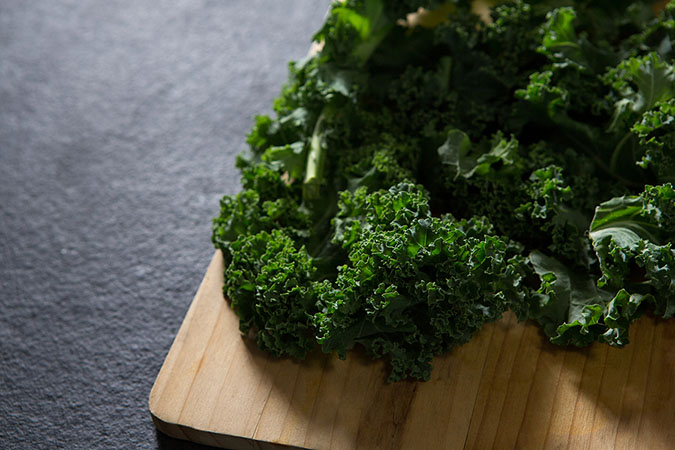
Raw mustard greens are full of nutrition.
Ridiculously Nutritious
100 grams or 27 calories worth of raw, chopped mustard greens contains more than your daily requirements of Vitamins K, C, and A.1)https://www.nutrition-and-you.com/mustard-greens.html
That makes it a powerhouse for building and maintaining strong bones; a great source for flu and cell damage prevention; and a promoter of strong teeth, healthy mucous membranes, and good eyesight.2)https://medlineplus.gov/ency/article/002400.htm Those same 27 calories also give you 11% of your daily dose of calcium, 18% of copper, 21% of manganese, and 20% of iron.
You May Also Enjoy:
“Growing Arugula: The Rocket in Your Salad Bowl and Garden (With Recipe)”
“Chard en Garde Manger: The Delicious 3-Season Green for Food Security”
Regular use of mustard greens in your diet may also prevent arthritis, osteoporosis, iron deficiency anemia, and high cholesterol, while offering protection from cardiovascular diseases, asthma, and colon and prostate cancers.
Delicious
A lot of people find mustard too peppery or bitter. However, that is often because the mustard they have tried is grown in spring or later and never receives the sweetening effect of a few light frosts.
Winter mustard still has a bite, but it is much more palatable than the warm-weather stuff. And besides, an appreciation for a bit of bitter is easy to cultivate.
You May Also Enjoy:
“All Hail, Kale! Growing Kale at Home (With Recipe)”
Cook your mustard greens in bacon grease and apple cider vinegar with dried fruit or a spoon of honey to turn them into a decadent treat.
Then listen to your body and see how that green goodness makes you feel. After a couple times of doing that, you might find yourself munching on raw leaves before those greens even make it out of your garden.
Easy to Grow
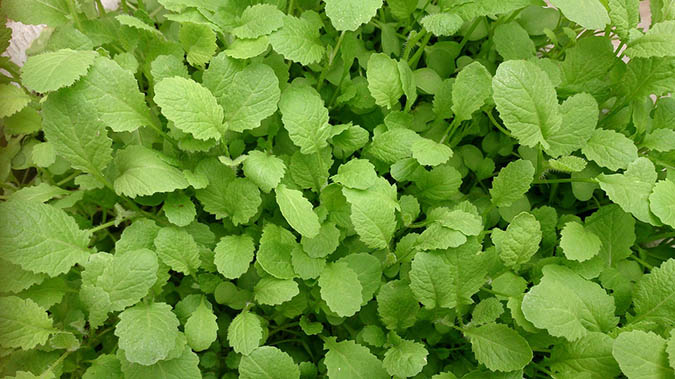
Image by Naeem Akram from Pixabay
You can have sprouts in days, baby greens in just a couple weeks, mature plants to cut from in 45–50 days, and your own seeds to save and replant in 90 days.
They are vulnerable to certain pests and diseases, but these can be almost completely avoided by growing mustard during cold-weather months.
Mustard can grow in almost any soil type, withstand drought conditions almost as well as wheat, and self-seed to produce a continuous crop with almost no work on your part.
Help Control Pests and Diseases in Your Soil
When chopped and incorporated into your soil just prior to flowering, mustard greens act as a biofumigant. They suppress pests and diseases through the release of inhibitory chemicals created when water and soil enzymes break down the glucosinolates in the greens.3)http://www2.gnb.ca/content/dam/gnb/Departments/10/pdf/Agriculture/GrowingMustardBiofumigation.pdf
(For more details on mustard as a biofumigant, check out this publication.)
When Allowed to Flower, Make Great Winter Forage for Pollinators Like Honey Bees
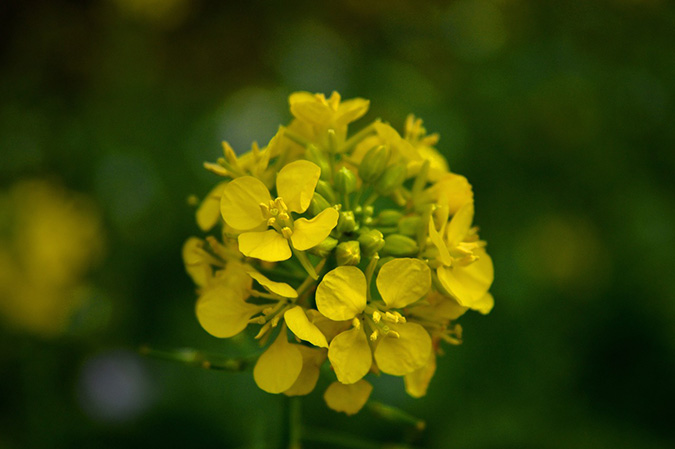
When you’re growing mustard greens and let them flower, they provide winter forage for bees and other pollinators. – Image by Frauke Riether from Pixabay
Until I discovered the wonders of growing mustard, I had a shortage of bee food for our coldest winter months.
Now, by starting mustard in waves about every two weeks, cutting greens until my new plants come in, and then allowing my old plants to flower, I have another pollen source for those brave foragers that venture out on sunny, slightly warm days.
Oh, and did I mention that mustard can also be grown for seeds to make…
Recipe: Homemade Mustard
Here’s a basic ratio recipe that you can adapt to use for whatever flavor profiles you like. Personally, I use an herbed vinegar infused with sage, thyme, and rosemary as my base and I sub in whey for water. But this is your personal mustard mix, so go crazy!
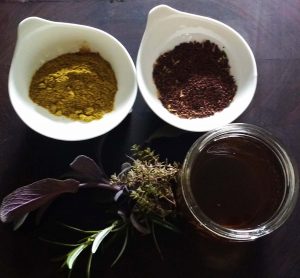
Easy Homemade Mustard Recipe
2 parts mustard seeds, finely ground (use a coffee grinder to make into powder)
2 parts mustard seeds, whole (for “L’ancienne” style)
1 part your favorite vinegar
2 parts water (or other liquid—beer, cider, etc.)
Salt and pepper
Whatever other stuff you want to add—tarragon, sage, thyme, rosemary, honey, etc.
Mix ingredients in jar. You can put this in the fridge to meld for a couple days. Or better yet, if you like to ferment stuff, use live vinegar (i.e., with the mother) and go ahead and leave it on the counter with a coffee filter or cloth over the top of the jar, secured with a rubber band, for 3–4 days.
If the mix is too thick after a couple of days, add a bit of water, or other liquid, until you get the right consistency. If you don’t love the whole-grain texture, then run it through the food processor or start with 4 parts ground mustard seed instead. If you accidentally make it too thin, add more ground mustard seed. Mustard is pretty hard to mess up, so don’t be afraid to experiment.
A Few Cautions About Mustard
Now there are also a couple of things to be aware of before you make mustard part of your garden and your diet.
It’s a Cole Crop
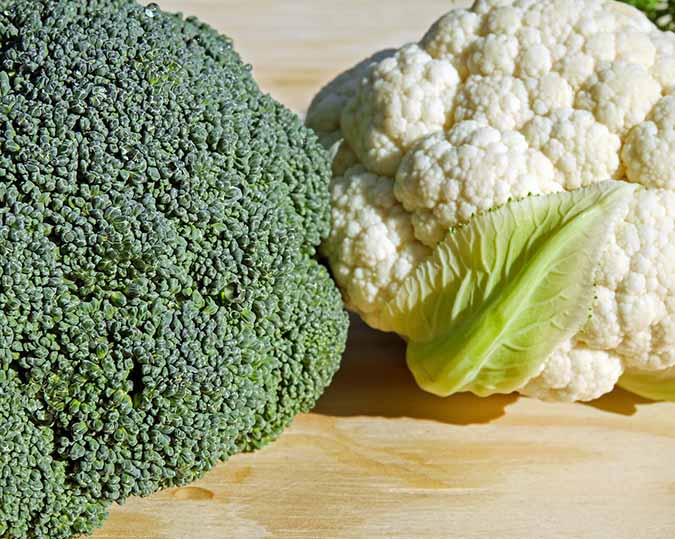
In your rotational planning, mustard should be counted as a cole crop, like broccoli or cauliflower. – Image by Couleur from Pixabay
If you are using rotational planting as a method for limiting pests and pathogens and managing nutrients in your soil, then even when you use mustard as a biofumigant cover crop, you should still count it as a cole crop in your four-year (or longer) rotation plan just as you would cabbage and cauliflower.
You May Also Enjoy:
“Growing Cole Crops – Broccoli, Cabbage, Cauliflower, and More”
“Crop Rotation for the Home Garden, Part 1: Pest Control”
“Crop Rotation for the Home Garden, Part 2: Pathogen Prevention”
“Supercharge Your Garden! 4 Steps to Vibrant Soil Using Compost and Crop Rotation”
Health Concerns
Be cautious about eating mustard if you are taking blood thinners, need to restrict oxalic acid, or have a thyroid condition.
Those high levels of Vitamin K can be an issue for people taking drugs like warfarin.4)https://health.clevelandclinic.org/2015/12/vitamin-k-can-dangerous-take-warfarin
Mustard contains oxalic acid, which can lead to oxalate urinary tract stones in prone individuals.
Components of mustard greens may be contraindicated in people with thyroid conditions.
Nutrient Overload?
You can have too much of a good thing. If 27 calories of mustard greens contain all that goodness we covered above, eating lots of mustard greens, such as by juicing them, might result in nutrient overload.
Most dietary recommendations for mustard greens include eating a couple of cups a week, on a daily or every-other-day basis.
Concerns With Reheating
Reheating mustard greens should probably be avoided. Vegetables contain nitrates. Nitrates may convert to nitrites if you cook, cool, and then reheat your vegetables.5)https://www.nutrition-and-you.com/mustard-greens.html
Since mustard greens are great raw or cold, and are easy to cook, skip the reheating to eliminate potential health risks.
I love and eat mustard regularly, but I do so in moderation and I don’t have any special health considerations that would make it problematic for me.
You May Also Enjoy:
“Heat? Drought? Delicious Oak Leaf Lettuce Thrives Anyway!”
“In Praise of Growing Parsley (With Recipe)”
“Purslane: The Omega-3 You Can Grow for Free! (With Recipe)”
Since I can’t possibly be considered qualified to make decisions or recommendations for you, as in all things, I trust that you won’t blindly follow mine or anyone else’s advice on what you put in your body (or even in your garden, for that matter).
So with the pros, cons, and necessary legal advisement that I am not telling you want to do behind us, if mustard is right for you, then I encourage you to get growing using the info and ideas below.
Growing Mustard Greens
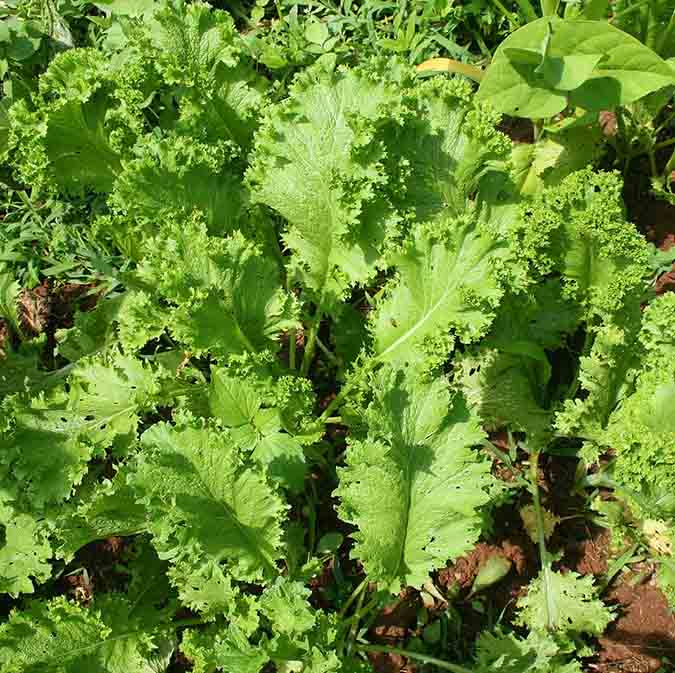
Image by Heidi Hanson from Pixabay
Soil Preparation
Mustard is pretty forgiving of poor soil quality. However, if you want faster growing times and really tasty mustard, then plant mustard in loamy garden soil with a pH of about 6.5-6.8.
If you don’t have that, don’t fret—just incorporate a few inches of good compost into whatever soil you have, add a handful of granite or other stone dust, and water deeply a few days before you transplant or seed. Note: This will not give you the best garden soil ever, but since mustard is much less picky than other cole crops, it will get you started.
Seed Starting
Mustard can germinate in soil temperatures as low as 40°F. That means that, depending on your climate, some of you may even be able to start some in your garden now.
Keep in mind that things grow slower when days are short, so you may have to wait a while for seeds to sprout and plants to mature.
For those who live in marginal climates, you can try to start seeds under cloches or cold frames.
Failing that, starting under grow lights and growing out until plants have a few true leaves, then transplanting and protecting under cloches or row covers can also work. If it is just too cold where you live to grow winter mustard, then consider using mustard seed for microgreens to tide you over until you can grow some in the garden.
You May Also Enjoy:
“Grow Microgreens and Sprouts Indoors All Winter Long”
You can start your seeds in planting, potting, or straight-up ground soil. As far as I can tell, mustard doesn’t care as long as your seed-starting medium is disease free, loose enough for young roots to grow in, and kept moist.
Young Plant Care
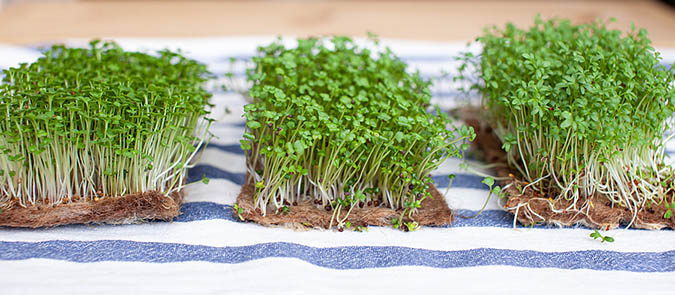
If you are growing mustard in cold conditions, juvenile plants may need some additional protection during extended cold or frost periods. Cold frames, cloches, or row covers can all help protect plants until they develop strong roots and even after if you live in extra cold areas.
Though mustard is drought resistant, for the best results in winter, you really want to water regularly until the plants are at least 6 inches tall.
I water the root zone of the plant until the soil is moist to about 3 inches down—which, conveniently, is about the length of my pointer finger.
I check the soil moisture every other day by sticking my pointer finger into my soil near my plants to make sure it’s still moist.
I can’t tell you exactly how much or how often to water because it really depends on your soil type and weather conditions. But by using the 3-inch rule, you are giving young mustard roots a good start.
Mature Plant Care
For best flavor and frost resistance, continue to water mature plants. Water at the root rather than the leaves for best cold resistance. Harvest leaves regularly and cut off any flower shoots that form until you are ready to let your plant flower and seed.
Harvesting
You can cut baby greens for use in salads with a pair of scissors. Be careful not to disturb the roots. You can also cut mature greens to chop up and eat raw, sauté, or steam. In addition, flowers can be tossed into salads.
Dry your seed heads in a paper bag, then shake the bag until the seeds fall out of the pods. Sift or use a fan to blow off the chaff.
Varieties of Mustard
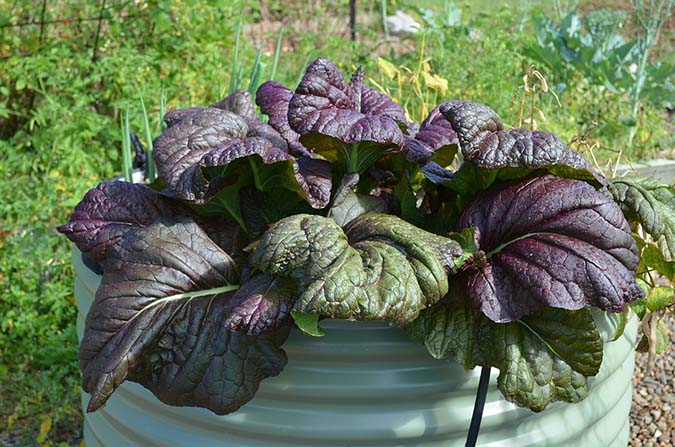
There are multiple types of mustard greens, including purple and red varieties. – Image by Mark Valencia from Pixabay
There are quite a few varieties of mustard available. Versions like Mizuna and Tatsoi tend to be a little higher maintenance than the Southern Giant, Green Wave, Florida Broadleaf, or Old Fashioned. There are also different seed colors—yellow mustard (called white mustard in Europe) is the most common variety used for seed and cover crops and is mildest in taste. Black or brown mustards are a bit tangier.
Unconventional Growing Tips for Adventure Gardeners
Mustard is one of those plants that readily self-seeds if you let it. So, in addition to planting mustard intentionally, I also scatter seeds directly in my garden after they dry on the plant. Then I just let nature take its course—as in, don’t water or fertilize to force germination. Literally just let them lie until they eventually get buried in soil and are triggered by the right conditions to grow on their own.
You May Also Enjoy:
“Growing Spinach: Pack a Punch in a Little Bunch”
“Sweet Potato Vines: How to Grow This Antioxidant Powerhouse”
“The Grapes of Youth: 11+ Age-Defying Reasons to Love This Plant”
Some seeds will inevitably germinate in summer, and since I know they will perform poorly in my hot, humid conditions and be eaten by harlequin bugs or host the dreaded cabbage moth, I pinch those plants out and give them to the chickens or toss them into my salads.
I only allow the plants that germinate in fall or winter to continue growing. If I don’t like their initial location, I’ll transplant them to a bed of my choosing while the plants are still young.
Then, the plants that do well all winter long get to flower and seed. Those plants, rather than my intentionally planted mustard plants, become my seed stock for next year.
By doing this, I have created mustard plants that are adapted specifically for my growing conditions here and are more cold hardy than my initial seed stock.
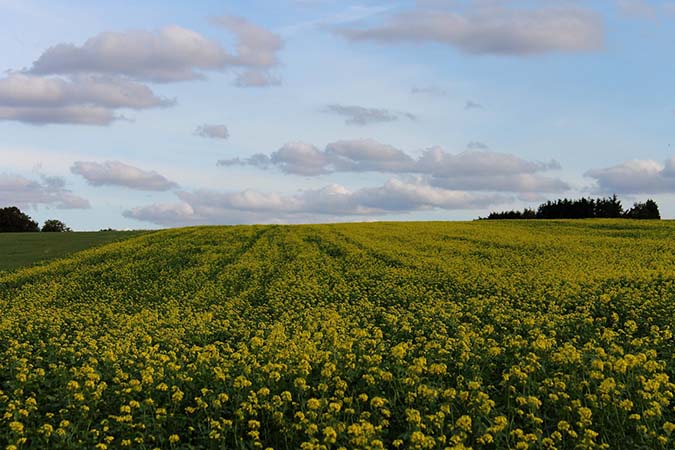
Image by Jasmin Raffaele from Pixabay
A Simple Trick to Extend the Growing Season
I also use a cheap season extension trick to get the most from my plants until I let them seed:
- I take a dark-colored 5-gallon bucket with a 1-inch hole drilled in the bottom and fill it with uncomposted materials like chicken manure, straw, late-season grass clippings, and kitchen scraps.
- I put the filled bucket in the center of my mustard bed.
- The mustard grows around the bucket and, as the materials in the bucket compost, they heat up and warm the plants.
- Also, when it rains, the rain water trickles through the hole in the bottom of the bucket and makes a kind of compost tea that feeds the plants.
- The dark-colored bucket also draws heat from the sun and cuts down on frost on the plants.
- If stuff composts too fast, I just add more goodies to keep it composting all winter long.
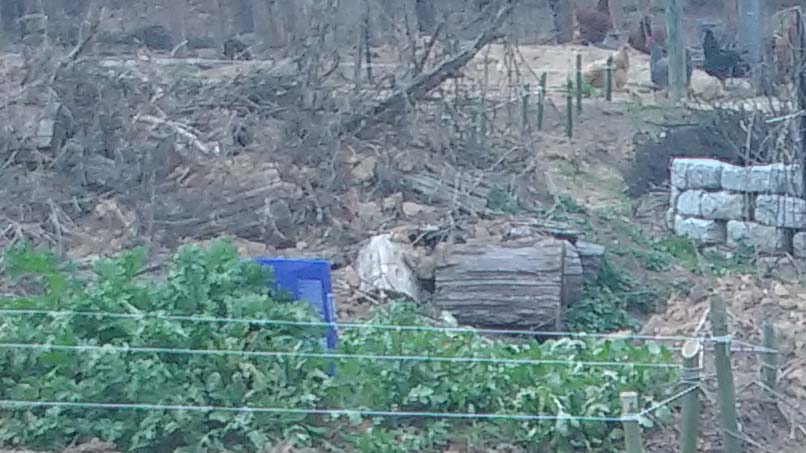
The photo above shows a mustard bed planted in September 2016, that was still growing like mad in February 2017 when I turned over the rest of my garden for spring planting. (You can see my blue season-extending compost bucket in the picture, too.)
It was growing so well, that I harvested from that bed until May when I finally let it seed. That’s 9 months of prolific mustard greens during some of the most difficult growing months. While I can’t swear you’ll have the same results, if you are an experimental gardener like me, I hope you’ll give it a try!
What Do You Think?
I’d love to hear your thoughts on mustard and if you have any tricks or tips to share with all us winter-green growers. You can use the comments section below to share your experience and ideas. Thanks!
_______________
This is an updated version of an article that was originally published on January 3, 2018. The author may not currently be available to respond to comments, however we encourage our Community members to chime in to share their experiences and answer questions!
The Grow Network is a participant in the Amazon Services LLC Associates Program, an affiliate program designed to provide a means for our team to earn fees for recommending our favorite products! We may earn a small commission, at no additional cost to you, should you purchase an item after clicking one of our links. Thanks for supporting TGN!

Tasha Greer is a regular contributor to The Grow Network and has cowritten several e-books with Marjory Wildcraft. The author of “Grow Your Own Spices” (December 2020), she also blogs for MorningChores.com and Mother Earth News. For more tips on homesteading and herb and spice gardening, follow Tasha at Simplestead.com.
References
| ↑1, ↑5 | https://www.nutrition-and-you.com/mustard-greens.html |
|---|---|
| ↑2 | https://medlineplus.gov/ency/article/002400.htm |
| ↑3 | http://www2.gnb.ca/content/dam/gnb/Departments/10/pdf/Agriculture/GrowingMustardBiofumigation.pdf |
| ↑4 | https://health.clevelandclinic.org/2015/12/vitamin-k-can-dangerous-take-warfarin |
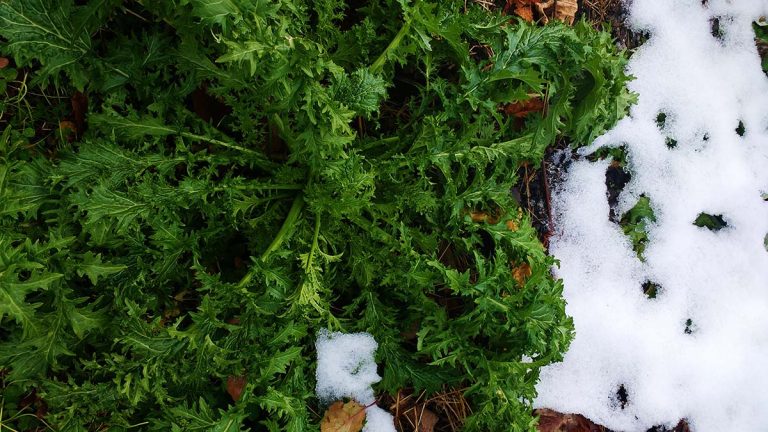







COMMENTS(13)
Thank you for a well written article. I am in La Pine, OR and have had similar results; winter’s cold does indeed improve mustard’s flavor.
I loved your article, and I can hardly wait to try this!
Too much snow where I live to grow it outside and actually tend to it unless I use a cold frame. Inside today, watching the blizzard outside and poring through gardening catalogues. How long do the seeds stay viable? I have some mustard seeds that are two years old, and think starting some inside might be nice to do; the garden already has a foot of snow on it, and we’re going to get at least another foot before this storm is over.
Hey Megan – Mustard seeds are usually viable for about 4 years if stored in optimal conditions. You can always try sprouting a few using a wet paper towel to see if they are still good. If for some reason your seeds don’t sprout, then you can still use them for mustard sauce.
A hot drink and seed catalogs sounds like the perfect antidote to a foot of snow in the garden! Hope you enjoy your spring garden planning! And good luck sprouting your mustard seeds indoors. Tasha
Thank you for this – particularly the mustard seed recipes – must give that a try. Let mine go to seed last year and have an abundance of self sets. No frosts here (Bermuda) to deal with:)
I will definitely try mustards. No frost here in Hawaii, but lots of critters wanting to share the rewards. Maybe mustards will help me send them across the street to another location. : )
Colleen – Sorry I didn’t reply sooner. I lived in Maui for a year. It was beautiful and everything seems to grow well there. Mustards are a bit more critter resistant than more tender greens, but I always like to grow extra just in case I have to share more than I want to with the wild things! In your area, you might have the best luck growing them as baby greens. If you pick them small, they tend to be just about as tasty as after a frost. Good luck to you! Tasha
I just moved to West Virginia from Minnesota. Now I am in Zone 6!! Can definitely use these ideas next fall. Also, I grew up in Maryland, and kale is a winter crop there. It rains constantly here. I’m planning raised beds with drain pipes and gravel on the bottom so that my plants won’t drown.
Hey Susan – Sounds like you have a good plan to keep your plants happy! You can even start mustard now in your zone. Your greens won’t be quite as delicious as winter grown mustard, but cooked with some butter or bacon grease and a bit of vinegar, they’re still a fabulous, nutritious treat! Good luck with your new garden beds! Tasha
Love the compost bucket with the plants around it; I will be using that for sure!
This idea works great in an edible landscape too. But you can do it with prettier containers, like dark colored pottery pots. Hope it works well for you!
I love mustard! Two years ago I had great luck growing mustard, but last year it wouldn’t grow. I wonder if I waited too long and it got too hot. I can’t imagine it would survive the winter here where the temp goes below zero, but it sounds like I should sow really early in the spring.
I’m not sure what caused your mustard not to grow. Mine grows even in hot weather, it just bolts and doesn’t taste good. It could be that something was wrong with the seeds or maybe a soil pH issue. But it’s hard to say without more details. Maybe start with some new seeds. If you don’t mind irregular germination, scatter them now and see when they come up on their own. Good luck with your greens!